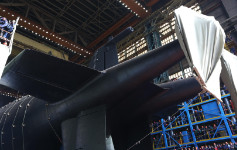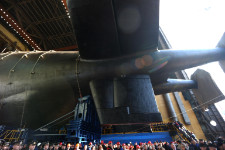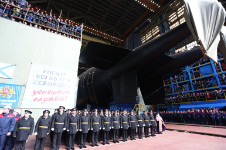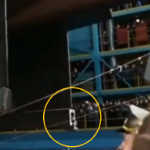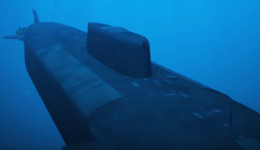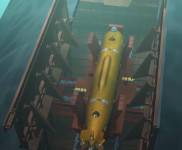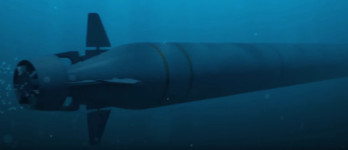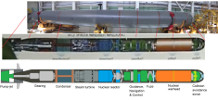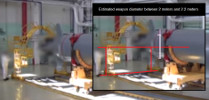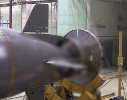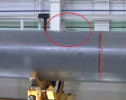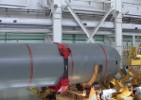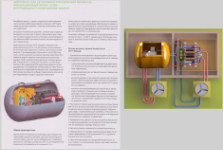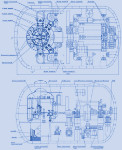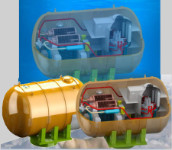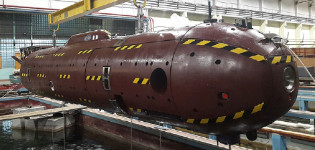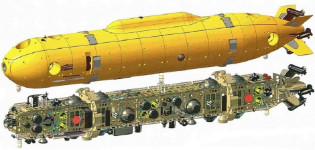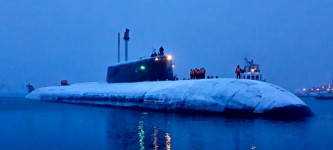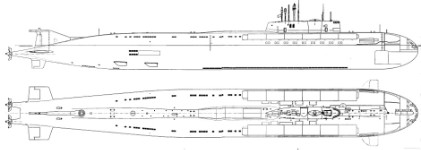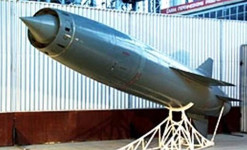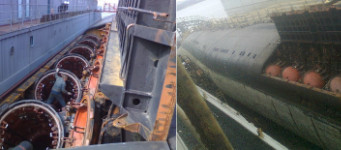Updated. Originally posted 25th June 2016
Project 09852 K-329 Belgorod ("Белгород")
 On 23rd April 2019, in a ceremony in the arctic town of Severodvinsk, Russia launched its latest and largest ‘special mission’ submarine, Belgorod. Measures were taken to control images published in the media, which only showed the rear-most section of the submarine. The same day a commercial satellite passed west of the city, snapping an image looking in through the rarely open doors of the construction hall. The canvas covers on her twin screws (propellers) are visible inside the hangar, as is the floating dock which is lined up outside in the basin to receive her. This is the first of many commercial satellite images which will reveal many more details about this enigmatic boat.
On 23rd April 2019, in a ceremony in the arctic town of Severodvinsk, Russia launched its latest and largest ‘special mission’ submarine, Belgorod. Measures were taken to control images published in the media, which only showed the rear-most section of the submarine. The same day a commercial satellite passed west of the city, snapping an image looking in through the rarely open doors of the construction hall. The canvas covers on her twin screws (propellers) are visible inside the hangar, as is the floating dock which is lined up outside in the basin to receive her. This is the first of many commercial satellite images which will reveal many more details about this enigmatic boat.
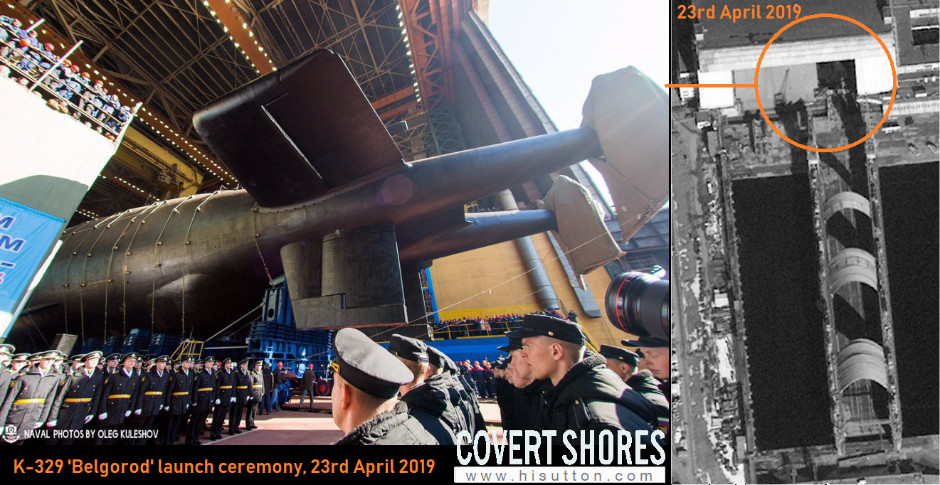
Original artwork - CLICK for HIGH-RESOLUTION image:

Update on previous analysis: I have seen substantially more satellite imagery than I can share at this time (thanks partly to Jane’s!) . This analysis is largely based on that, together with a reevaluation of previous analysis.
- Belgorod is marginally shorter than predicted, at ~178 meters (versus 184 meters previous estimate). The hull insert required to accommodate the Losharik deep-diving midget submarine is shorter than estimated, at around 18-20 meters, but the bow section is also longer. As expected, the sail is shorter.
- Belgorod is narrower than the original OSCAR-II design. This is because the Poseidon Intercontinental Nuclear-Powered Nuclear-Armed Autonomous Torpedo are carried in the bow similar to the future Pr.09851 Khabarovsk Class instead of beside the hull in the manner of the OSCAR-II’s missiles. Belgorod has a roughly circular cross-section of ~15 meters diameter.
- the exact configuration of the six Poseidon tubes is unclear. Possibly they are in a rotary launcher to minimize the number and size of the launch doors and easy loading of the weapons. However they may also be in rows, in which case they are possibly loaded from above. When better images emerge of the bow section we may be able to infer the layout from hints in the arrangement of hatches and doors.
- It is unclear where the torpedo room is located. It seems unlikely that it has been done away with however.
Original artwork - CLICK for HIGH-RESOLUTION image:

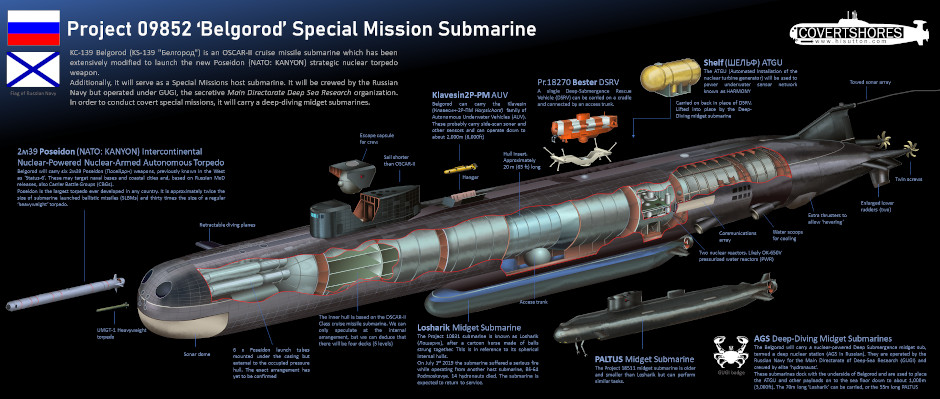
Overall the previous analysis remains valid however. Belgorod will be one of the largest submarines in the world and will play a key role in building military infrastructure deep under the Arctic as well as carrying the new Poseidon Intercontinental Nuclear-Powered Nuclear-Armed Autonomous Torpedo. She was an unfinished OSCAR-II cruise missile submarine KC-139 which is being converted to serve as a Special Missions host submarine. she will be crewed by the Russian Navy but operated under GUGI, the secretive Main Directorate Deep Sea Research organization. In order to conduct covert special missions, it will carry a deep diving midget submarine, large payloads and the new KANYON (Status-6) strategic nuclear torpedo weapon. The project started in 2010, with the refit commencing in 2012, and she was finally launched on 23rd April 2019.
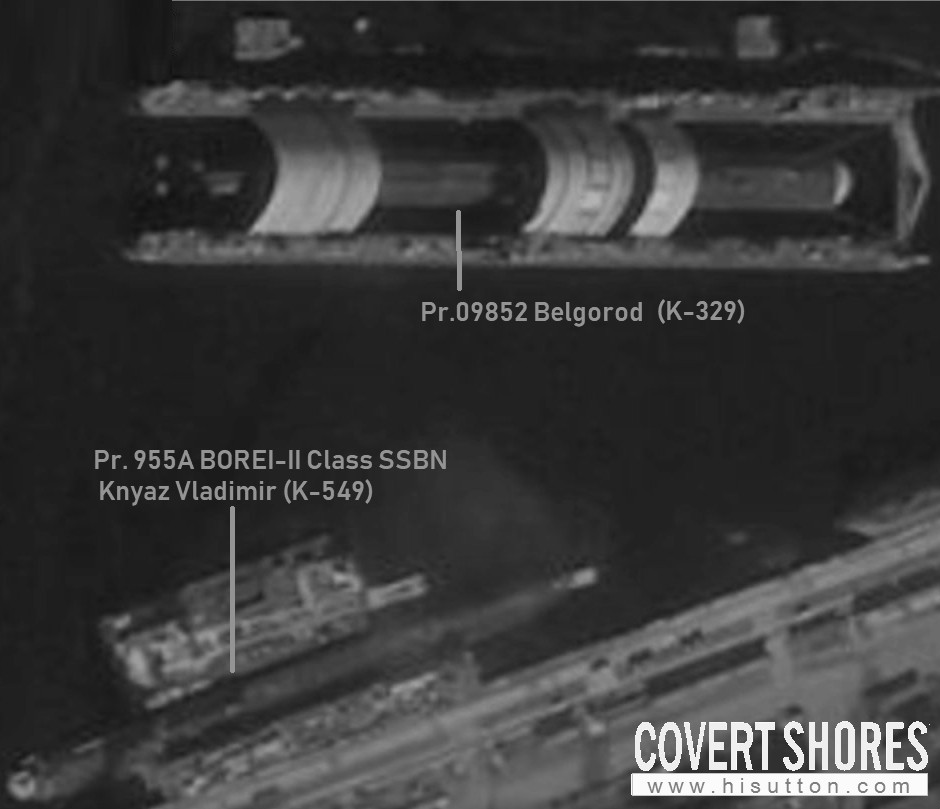
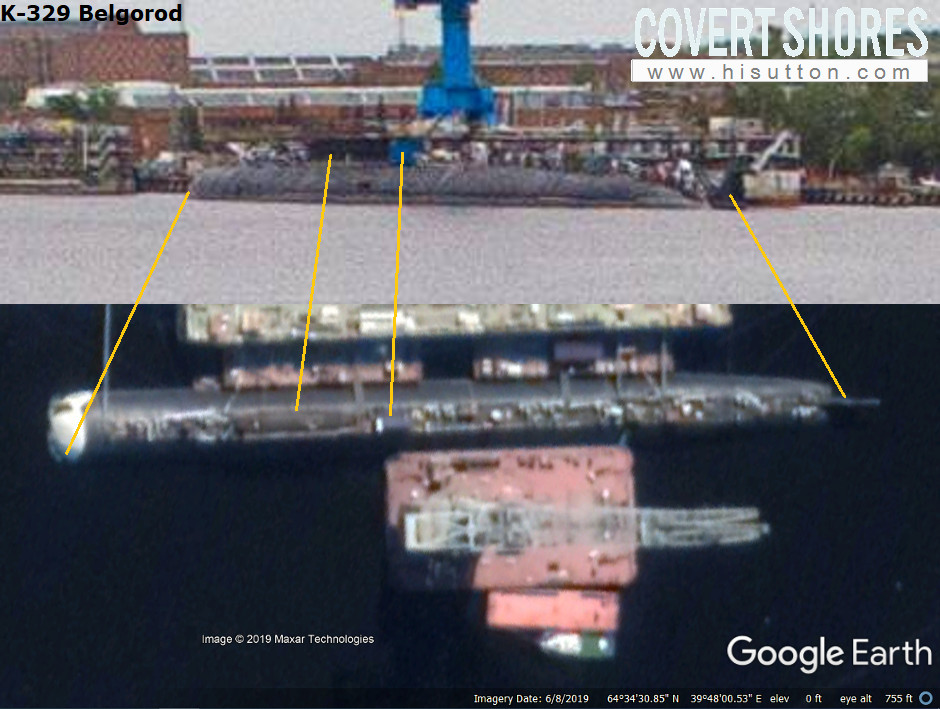
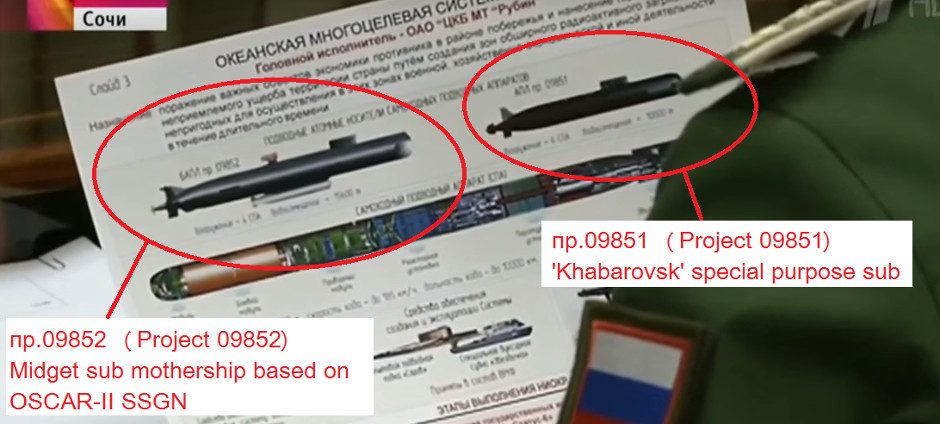
The infamous 'Status-6' media leak from November 2015. Project 09852 Belgorod is shown top left. Note that as well as mentioning the Status-6 torpedo (NATO: KANYON), it depicts a midget submarine under the Belgorod and a payload on the back.
On 1st March 2018 a video was released by the Russian MoD (http://vote.mil.ru/vote/oms.htm) inviting people to name Russia's newest weapon(s). The clip showed the Belgorod launching a KANYON and Harpsichord-2P-PM AUV. The Status-6 weapon was subsequetly renamed Poseidon:
Get The essential guide to World Submarines
This Covert Shores Recognition Guide Covers over 80 classes of submarines including all types currently in service with World Navies.Check it out on Amazon
Pr09852 Belgorod Specifications (Provisional)
Displacement: greater than 14,700 tonnes surfaced (est. 17,000 tonnes), 24,000 tonnes submerged (estimated 30,0000 tonnes)
Length: ~178 meters
Beam: ~15 meters
Speed: < 32 knots
Range: Unlimted
Endurance: Approximately 4 months
Operating depth: Estimated as 500-520 meters per OSCAR-II SSGN
Propulsion: nuclear (2 x pressurized water reactor OK-650M.02 with a capacity of 190 MW driving two steam turbines and twin screws. Plus at least two outboard thrusters.
Crew: TBC. estimated 110
Armament: 6 x Poseidon (KANYON) nuclear torpedoes , 6 x 533 mm (21") torpedo tubes (tbc)
1. 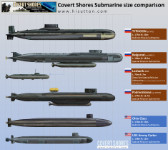 2.
2. 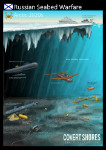 3.
3. 
- Submarine size comparrison (Original artwork). 2. Original artwork was originally commissioned by Janes Intelligence Review from IHS Markit. 3. Translated Shipbuilder's statement covering work on Belgorod
Poseidon Intercontinental Nuclear-Powered Nuclear-Armed Autonomous Torpedo
Poseidon is the largest torpedo ever developed in any country. At around 2 meters (6.5 ft) in diameter and over 20 meters (65 ft) long, it is approximately twice the size of submarine launched ballistic missiles (SLBMs) and thirty times the size of a regular ‘heavyweight’ torpedo.
Original artwork - CLICK IMAGE FOR HIGH-RESOLUTION:

Although the Belgorod conversion has been followed by some analysts since around 2010, it only made headlines (indirectly) in November 2015 when it appeared on the infamous ‘leaked’ STATUS-6 presentation. The submarine was depicted in the top left, stating that it would carry six of the new nuclear powered nuclear armed strategic torpedoes previously known as Skif (NATO: KANYON). These torpedoes are massive at 24m (80ft) long and 1.6m (5.25ft) in diameter, and are designed to strike coastal cities. They can be thought of as an SLBM but in a torpedo form.

When first revealed in the leak, many observers were quick to dismiss the KANYON as impractical. The stated specifications, especially the warhead, seemed ‘optimistic’. And although it is nearly impossible to counter with current weapon systems, it made no sense as a First Strike weapon because it is comparatively noisy and slow; even at an incredible 60kt speed it would take days to reach a target. It is also unsuitable for striking moving targets such as carrier battle groups although it is presented as a multi-role weapon by the Russians. The remaining option, which does make some sense, is as a Second Strike weapon intended to be fired in retaliation. Any difficulties countering it can only be made more difficult still in the event of a nuclear war, and the system can likely function without satellite input, making it less vulnerable than SLBMs/ICBMs (can be debated).
Its deployment on Belgorod is not straightforward. Structurally the submarine is ideal with massive missile bas either side of the hull which will now be empty. These are more than large enough for the KANYON tubes which will probably be angled to fire out through the side, thus minimizing changes to the forward hull and avoiding compromising the sonar spaces. And the gigantic submarine probably has enough reserve buoyancy to carry the system plus the midget sub and ATGU payload.
However, carrying a special mission submarine and payload, and carrying a strategic weapon are contradictory missions. Some would say mutually exclusive. That the boat is slated for both missions seems clear, so the question is how? It is possible that she will deploy in one role or the other depending on the patrol pattern, covering for the only other KANYON submarine, the purpose built P.09851 KHABAROVSK.
‘HARMONY’ submarine detection network
note: In Novemember 2017 Russian state media gave the name Harmony (Гармония) to describe this 'global underwater sonar network'. I had previously provisionally used 'SHELF' (ШЕЛЬФ) which is the name of the nuclear power generator.
Analysis suggests that the main special mission of Belgorod will be the covert placement of large underwater systems on the sea floor. Russia is working on a new multi-sensor submarine detection network similar in concept to the US Navy’s classic SOSUS system which is intended to detect submarines operating under the arctic at ranges of 100km or more. According the sources quoted in the Russian media (Izvestia, 20th July 2016) the new complex will involve ‘underwater sensors’ (sonar arrays and possibly pressure/wake detectors) and sonar buoys, and will communicate with control stations via satellites. The system itself, or components of it, are codenamed HARMONY.
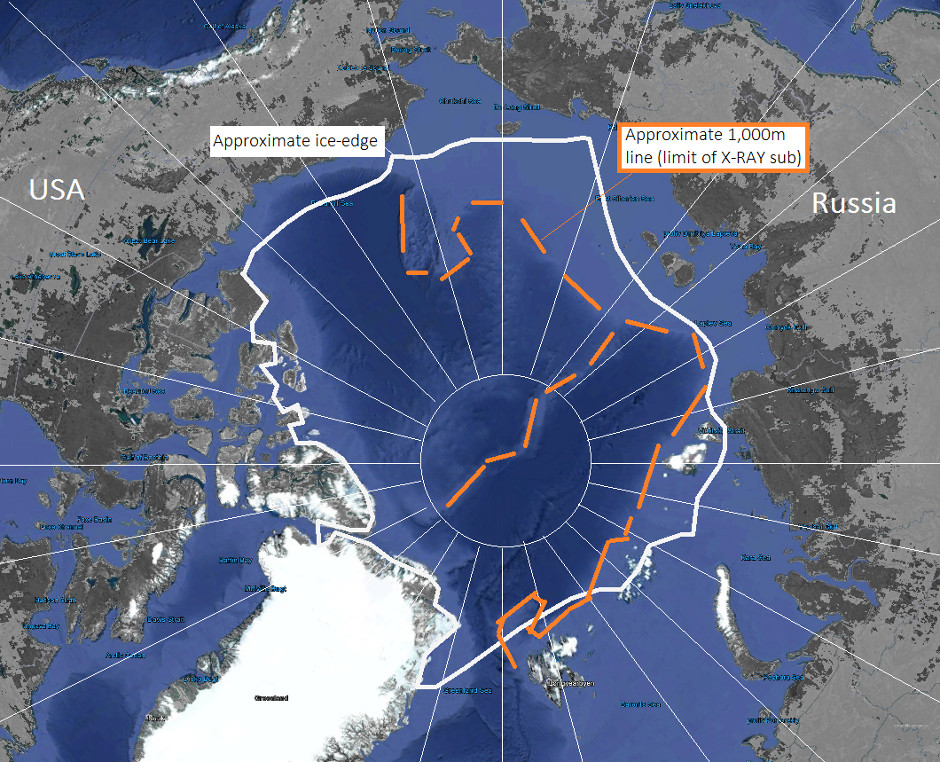
The Arctic Ocean has two basins in the middle, divided in half by a massive mountainous ridge. The basins are surrounded by shelfs where the sea floor drops from about 1,000m down to around 4,000m. Given that the midget submarines carried by Belgorod can dive to about 1,000m, these shelves represent the edge of where the sensor arrays might be placed. Additionally there are areas with mountain peeks at less than 1,000m where arrays could be placed.
This system will require the exact placement of a series of underwater constructions. Placement under the ice cap (which is implied) will be extremely complex, especially considering the need to power the system. Cables from the shore are difficult to place without surface ships above which is both impracticable and indiscrete, and are vulnerable to USN tracing and interference. The answer that the Russian planners have come up with it to place a series of self-contained nuclear power plants. These ATGU (Automated installation of the nuclear turbine generator) will be carried into position on the back of the submarine, and placed by the midget submarine (see below).
The ATGU has an integral Pressurized Water Reactor, a small-sized turbine generator installation, a simple thermal-hydraulic circuit and the minimum of ancillary equipment. It is enclosed in a cylindrical ‘Energokapsule’ which is 14m (45ft) long and 8m (25ft) in diameter.
According to the manufacturers the integral reactor allows for a simplified arrangement of the circulation path, reducing flow resistance. This provides a relatively high power level when operating on natural circulation (at least 65% of the max). It is still a relatively small low-density reactor however at 44 kW / l. It has moderate heat fluxes and significant reserves of coolant boiling.
The ATGU is a general purpose installation intended for on-land and undersea applications, and is likely to be passed off as having civilian applications even when carried by a Navy submarine. It will connect to one or more sensor arrays by a relatively short (and therefore light) cable. Any large sensor systems are likely to be carried on the Belgorod’s back in the same manner as the ATGU.
 Deep diving midget submarine
Deep diving midget submarine
The ATGU and other payloads will be placed on the sea floor by a nuclear powered deep submergence midget submarine, termed an ACS (deep nuclear station). Russia has used larger host submarines to carry its special mission midget subs into position since the 1980s. The Russian approach is to dock the midget submarine with the underside of the host submarine, making it invisible to the observers when on the surface. This positioning has actually been used since the 1960s when deep diving capsules where towed underneath specially modified submarines. This arrangement was continued with the emergence of the Project 1851 X-RAY Class nuclear powered midget submarine in the 1980s. The X-RAY was a close equivalent to the US Navy’s NR-1 submersible and is 44m (145ft) long and equipped with grabbers and manipulators.

Original artwork. CLICK for HIGH-RESOLUTION image.
There are currently three ACS midget submarines operational with the Russian Navy which are designed to be carried by host submerines:
- AC-21, an improved Project 18511 Halibut (PALTUS) class boat. About 55m long and can probably dive to around 1,000m (3,000ft) per the X-RAY
- AC-35, the second Project 18511 PALTUS. Slight differences to the first.
- AC-31, Project 10831 Losharik. Significantly larger at 70m and probably deeper diving.
1. 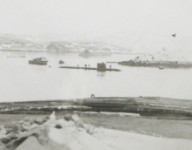 2.
2. 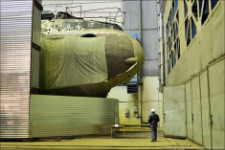 3.
3. 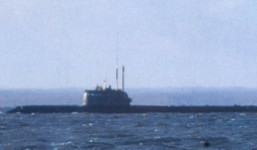
- Project 18511 Halibut (PALTUS). 2. Rare photos of X-RAY class' bow and underside, revealing configuration. 3. Losharik.
Automamous Underwater Vehicles (AUV)
Belgorod will almost certainly field UUVs (AUVs in Russian parlance: Automamous Underwater Vehicles). These carry an array of sonars including side-scanning, and are abl to map the sea floor in great detail and locate items such as wreckage and sensor arrays.
The Belgorod will be equipped with the improved Harpsichord-2P-PM (Клавесин-2Р-ПМ) which can be housed in a wet hanger behind the sail, where the towed communication buoy is situated on the OSCAR-II:

Specifications
Length – 6.5m
Diameter – 1m
Weight in air - about 3.700 kg
Range: - about 27 nm
Operating depth: 6,000m (according to Rubin. Some reports suggest ~2,000 m)
Before conversion: OSCAR-II Class
The OSCAR-II class is a large Cruise Missile submarine (SSGN) designed during the Cold War to take out the US Navy’s Carrier Battle Groups. These are massive and expensive boats, each costing around half an Aircraft Carrier. They are the second largest submarines ever built, behind only the Project 971 TYPHOON Class SSBN.
The OSCAR-II Class carry a formidable battery of 24 x P-700 GRANIT supersonic anti-ship missiles. These have a range of 340 nm and can carry a 500kt thermonuclear warhead.
The immense size of the submarine is apparent in these shots. Note that the walkway along the inside of the missile hatch outer doors when they are fully opened, visible on the left, is almost lost in the right hand image. The hull has five decks in some compartments.
Related articles (Full index of popular Covert Shores articles)

 Project 09851 Khabarovsk Class Submarine. w/Cutaway
Project 09851 Khabarovsk Class Submarine. w/Cutaway

 USS Jimmy Carter (SSN-23) Special Mission submarine
USS Jimmy Carter (SSN-23) Special Mission submarine

 AN-1 submarine aircraft carrier
AN-1 submarine aircraft carrier

 SMX-31 future submarine concept ('The Electric') w/Cutaway
SMX-31 future submarine concept ('The Electric') w/Cutaway

 Project 885 'YASEN' (Severodvinsk Class) SSGN. w/Cutaway
Project 885 'YASEN' (Severodvinsk Class) SSGN. w/Cutaway
 Type-XXIXH stealth U-Boat. w/Cutaway
Type-XXIXH stealth U-Boat. w/Cutaway

 Project 685 MIKE Class deep-diving SSN
Project 685 MIKE Class deep-diving SSN

 Project 955A 'BOREI-A' Ballistic Missile Submarine. w/Cutaway
Project 955A 'BOREI-A' Ballistic Missile Submarine. w/Cutaway

 Project 705 'ALFA' class attack submarine. w/Cutaway
Project 705 'ALFA' class attack submarine. w/Cutaway

 NR-1
NR-1

 Surcouf Cruiser Submarine w/Cutaway
Surcouf Cruiser Submarine w/Cutaway

 USS Parche spy sub par-excellence. w/Cutaway
USS Parche spy sub par-excellence. w/Cutaway

 BS-64 Podmoskovye Special Mission (spy) Host Submarine
BS-64 Podmoskovye Special Mission (spy) Host Submarine

 Harpsichord AUV
Harpsichord AUV

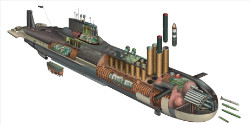 TYPHOON Class SSBN. w/Cutaway
TYPHOON Class SSBN. w/Cutaway

 Russian unbuilt spy submarine MPS
Russian unbuilt spy submarine MPS

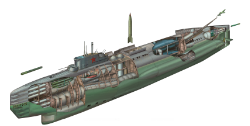 Stalin's Super Sub, Project P-2. w/Cutaway
Stalin's Super Sub, Project P-2. w/Cutaway

 Russian Losharik spy sub
Russian Losharik spy sub

 Russian Seismic Survey sub
Russian Seismic Survey sub

 Project 1910 UNIFORM Class deep diving spy sub
Project 1910 UNIFORM Class deep diving spy sub

 USS Halibut. w/Cutaway
USS Halibut. w/Cutaway

 USS Seawolf (SSN-575)
USS Seawolf (SSN-575)

 Russian X-RAY Class spy sub
Russian X-RAY Class spy sub

 Russian Sarov experimental sub
Russian Sarov experimental sub

 Attack Class
Attack Class

